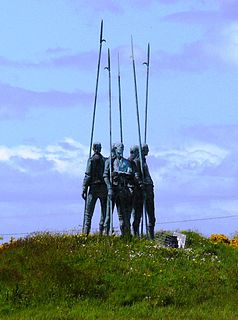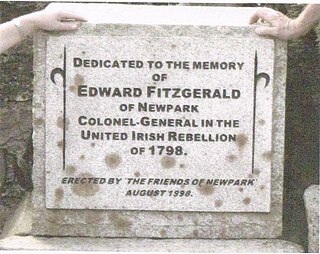
The Battle of New Ross took place in County Wexford in south-eastern Ireland, during the Irish Rebellion of 1798. It was fought between the Irish Republican insurgents called the United Irishmen and British Crown forces composed of regular soldiers, militia and yeomanry. The attack on the town of New Ross on the River Barrow, was an attempt by the recently victorious rebels to break out of county Wexford across the river Barrow and to spread the rebellion into county Kilkenny and the outlying province of Munster.

The Battle of Vinegar Hill, was an engagement during the Irish Rebellion of 1798 on 21 June 1798 when over 13,000 British soldiers launched an attack on Vinegar Hill outside Enniscorthy, County Wexford, the largest camp and headquarters of the Wexford United Irishmen. It marked a turning point in the rebellion, as it was the last attempt by the United Irishmen to hold and defend ground against the British military. The battle was actually fought in two locations: on Vinegar Hill itself and in the streets of nearby Enniscorthy.
The Battle of Ballyellis on 30 June 1798 was a clash during the Irish Rebellion of 1798, between a surviving column of the dispersed Wexford rebel army and pursuing British forces which resulted in a victory for the rebels.
John Kelly lived in the town of Killanne in the parish of Rathnure, west of Enniscorthy, in County Wexford in Ireland, and was a United Irish leader who fought in the Irish Rebellion of 1798.
Anthony Perry, known as the "screeching general" was one of the most important leaders of the United Irish Wexford rebels during the 1798 rebellion.
Boolavogue, also spelt Boolavoge or Boleyvogue, is a village 12 km northeast of Enniscorthy in County Wexford, Ireland. It is in the Roman Catholic Diocese of Ferns.

John Murphy was an Irish Roman Catholic priest of the Roman Catholic Diocese of Ferns, who is mainly remembered for his central role in the Irish Rebellion of 1798 in County Wexford, which is sometimes known as the Wexford Rebellion. He led the insurgents to one of their initial victories over a government militia at Oulart Hill, and in the following weeks became one of the rebellion's main leaders.
Events from the year 1798 in Ireland.
"Boolavogue" is an Irish ballad commemorating the campaign of Father John Murphy and his army in County Wexford during the Irish Rebellion of 1798. It was composed by Patrick Joseph McCall in 1898, the centenary of the Rebellion.

Lacken is a townland about two miles outside the town of New Ross in County Wexford, Ireland. It is located in the civil parish of Oldross and the electoral division of Whitemoor. Central to the area is Lacken Hill, a hill planted with a mix of coniferous and deciduous trees which has a public walk-way up through the wood. The area is used by walkers and cyclists and there are numerous paths and tracks in the wood.
Beauchamp Bagenal Harvey was a barrister and a commander of the United Irishmen in the Battle of New Ross during the 1798 Rebellion.
Father Mogue Kearns, sometimes called Moses Kearns, was an Irish Roman Catholic priest and United Irishman executed by the British on 12 July 1798, after leading 2,000 rebel troops in Wexford.

The Wexford Rebellion refers to the outbreak in County Wexford, Ireland in May 1798 of the Society of United Irishmen's rebellion against the British rule. It was the most successful and most destructive of all the uprisings that occurred throughout Ireland during the 1798 Rising, lasting from 27 May 1798 until about 21 June 1798. The Wexford Rebellion saw much success despite County Wexford not being thought of as an immediate threat by the government, because of the spontaneous risings that occurred both before and after the significant rebel victories in Oulart, Enniscorthy, and Wexford town.

Cornelius Grogan (1738?–1798), was a United Irishman and commissary-general in the insurgent army of Wexford in the Rebellion of 1798.
John Henry Colclough was United Irishman executed in Wexford following the Irish Rebellion of 1798.

Edward Fitzgerald (1770?-1807) was an Irish insurgent leader in the United Irish Rebellion of 1798.

Wexford Bridge is a road bridge in Wexford, the county town of County Wexford in Ireland. It crosses the mouth of the River Slaney from Wexford town on the west bank to Ferrybank on the east bank. It carries the R741 road from Wexford towards Dublin and the north. The bridge consists of 7 spans of maximum length 63 metres and 12 metres wide, made of continuous steel girders carrying composite concrete slabs. Including the approach roads, the total length of the bridge is 590 metres, of which 380 metres are over water.
Matthew Keogh or Keugh or Keough was the United Irish governor of Wexford during the Irish rebellion of 1798. Held responsible for a massacre of loyalists in the town, he was hanged following its recapture by Crown forces.

Vinegar Hill Windmill or Templeshannon Windmill is a tower mill on Vinegar Hill, Enniscorthy, County Wexford.
Slieve Coillte is a hill in the south of County Wexford, Ireland. The hill is the highest point on the Hook peninsula, with an elevation of 268.5 metres (881 ft).








